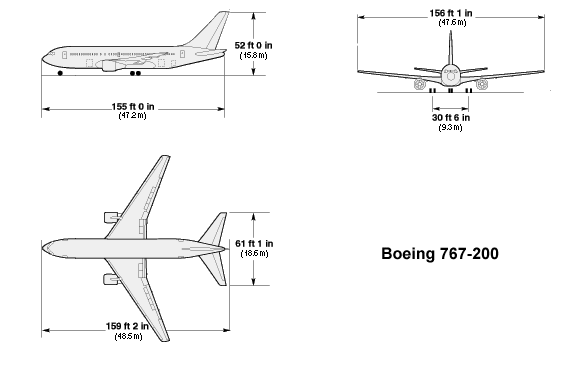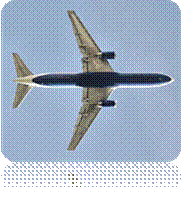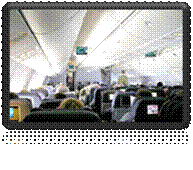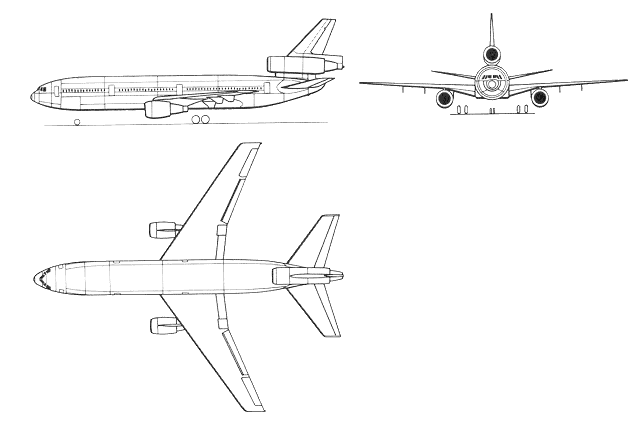Aircraft tactical-technical requirements development
Ministry of Education and Science of Ukraine
National Aerospace University
by N. E. Zukovskiy “KHAI”
Department № 103
Course Project
Passenger aircraft as B 767
Calculate-drawing work
On course “General Arrangement of Airplane ”
Direction 6.05110102 Aircraft and Rocket Engineering (Manufacturing)
Submitted by student gr.
Kaluzna O.O.
Checked by
Senior teacher Danov A. S.
Kiev 2016
Abstract
This book has been developed for use in the preliminary and degree course project in aircraft design at National Aerospace University. Kharkov. Ukraine
Eachyearstudentsworksinglyonaprojectedaircrafttodesignsubstantialpartsofairframeandsystems.Muchofthematerialandillustrationshave_been_produced_undertheUniversity's__cademic_syllabus_in_Aviation and astronautics under the supervision of the staff. This enables students to develop much more detailed concepts in design of various types of Airplanes and structures.
This book concentrates in the design of a new dimensional mid-range passenger non maneuverable aircraft in which all statistical data's of other six proto types all of the same purpose and almost similar design are gatheredand studied.The technique and dependences for main parameters like take-off mass, RangeCruise speed, number of passengers and eometrical parameters of units in zero approximation.Load carrying structures of wing. Fuselage, landing gear tail Unit and Spar design as the main member of the wing is also discussed in this book
This manual also covers Aircraft aerodynamic and flight performance calculations and determination ofwing regular zone elements geometry from their static strange condition.It also explains the Analysis of engine mounts airframe and their structural features of the same typeaircraft considered. Power plant engine mounting design and calculation, Fuel system that includes fireprotection, dumping and venting systems as well as lubrication system.Finally it includes aircraft part sheet punching manufacturing development and punch design by stampingmethod with final assembly drawing of die and punch.Finally, this book reveals some of the Economic and safety parts of some units used.
Much of the work in this book has been done with computer edited diagrams in AutoCAD software and other analytical software like power unit and geometry of aircraft in aerodynamics.
1.1 Collection of the Statistical Data:
We are considering 6 prototype airplanes (passenger) to construct a new aircraft as our course project. These aircrafts are similar in their dimensions and performance and capabilities. Calculations in zero approximation are based on use of the statistical data for parameters and characteristics of already constructed airplanes of a similar class.
The main necessity of designing a new airplane lies on the public need or requirements of a new and advanced aircraft. The development of an already constructed airplane in point of view of developed aerodynamic characteristics, developed range, developed payload capacity is also incorporated as designing. For these we have to choose first our prototypes and comparing with them we will try to fulfill the new requirements, for the new aircraft.
So the first factors that we will take into account are as follow:
1. Stating the needs of a new product.
2. Development of requirement of the aircraft.
3. Estimation of the realization of the requirements.
4. Development of the flight tactical-technical requirements to fit the estimation.
5. Preliminary designing.
6. Development of the outline sketches.
So when we understand the basic need or requirements for the construction of the new proposed design, we will layout the difference between the projected aircraft and the prototype.
| Characteristics | Prototype Aircraft Airbus A-300 B4 | Projected Aircraft |
| Range fully loaded (km) | ||
| Passenger Capacity | ||
| Cruising Speed (km/hr) |
Aircraft tactical-technical requirements development.
Boeing 767
The Boeing 767 is a mid-size, wide-body twinjet airliner produced by Boeing Commercial Airplanes. Passenger versions of the 767 can carry between 181 and 375 passengers, and have a range of 5,200 to 6,590 nautical miles (9,400 to 12,200 km) depending on variant and seating configuration.[4] The 767 entered into airline service in 1982. 
Fig1.1
Design

Fig1.2
Planform view of a British Airways 767-300 after take off. The landing gear has retracted.
The Boeing 767 is a low-wing cantilever monoplane with a conventional tail unit with a single fin and rudder. It has a retractable tricycle landing gear and is powered by two wing mounted turbofan engines.
The 767 offers a twin aisle configuration of 2+3+2 in economy with the most common business configuration of 2+2+2. It is possible to squeeze an extra seat for a 2+4+2 configuration. However, this seating is crammed and this is not common.[20] The 767 has a seat-to-aisle ratio in economy class of an efficient 3.5 seats per aisle, allowing for quicker food service and quicker exit of the airplane than many other jetliners, which typically have four to six seats per aisle in economy class.
It can carry freight in Unit Load Devices such as LD2s and LD8s. Its fuselage width does not allow larger ULDs such as LD6s, LD11s, and LD3s. One of the design requirements of the 767's replacement, the Boeing 787, was for it to use the LD3/6/11 family of ULDs to solve the wasted volume issue.
Newer 767-200s and 767-300s, as well as all 767-400ERs, feature a 777-style cabin interior, also known as the "Boeing Signature Interior". The 767-400ER also features larger windows exactly like those found on the 777. All new 767s built feature the Signature Interior, and it is also available as a retrofit for older 767s. In addition to the Boeing Signature Interior retrofit option, a simpler modification known as the "Boeing 767 Enhanced Interior" is available. This retrofit borrows styling elements from the Boeing Signature Interior; however, the outer section overhead bins are traditional-style shelf bins rather than the 777-style pivot bins.
Notable incidents
- On July 23, 1983, Air Canada Flight 143, a Boeing 767-200, ran out of fuel in flight and had to glide to an emergency landing. The pilots used the aircraft's ram air turbine to power the aircraft's hydraulic systems for control. There were no fatalities. This aircraft was nicknamed "Gimli Glider". The aircraft (C-GAUN) continued service within Air Canada until its retirement in January 2008.[40]
- On May 26, 1991, Lauda Air Flight 004 crashed following the in-flight deployment of the left engine thrust reverser. None of the 223 aboard survived. As a result of this incident engine thrust reversers on all 767s were ordered to be deactivated until the system was redesigned.[41]
- On November 23, 1996, Ethiopian Airlines Flight 961 was hijacked, ran out of fuel, and crashed in the Indian Ocean near Comoros. The pilots used the aircraft's ram air turbine as an emergency power source. Of the 175 aboard, 123 died. Still, the incident is one of the few instances of a plane landing on water with survivors.
- On October 31, 1999, EgyptAir Flight 990, a scheduled Los Angeles-New York-Cairo flight, in a Boeing 767-366ER, crashed off Nantucket Island, Massachusetts in international waters killing all 217 people on board. The cause, while disputed by the Egyptian government, is stated by the NTSB as, "a result of the relief first officer's flight control inputs."
- Two Boeing 767 aircraft were involved in the September 11, 2001 attacks, and both crashed into the two towers of the World Trade Center. In addition to those on board the planes, 2602 people perished on the ground, mostly in the two towers.
- American Airlines Flight 11, a 767-223ER, crashed into the north tower, with 92 fatalities on board.
- United Airlines Flight 175, a 767-200, crashed into the south tower, with the loss of all 65 on board.
- On December 22, 2001 Richard Colvin Reid tried to bomb American Airlines Flight 63, a flight from Paris to Miami using a Boeing 767. Passengers and crew prevented him from bombing the aircraft and he was arrested, convicted, and imprisoned.
- On April 15, 2002, Air China Flight 129 a Boeing 767-200ER from Beijing to Busan, South Korea, crashed into a hill while trying to land at Gimhae International Airport during inclement weather, killing 128 of the 166 people on board.

Fig1.3
McDonnell Douglas DC-10
The McDonnell Douglas DC-10 is a three-engine medium- to long-range widebody airliner, with two engines mounted on underwing pylons and a third engine at the base of the vertical stabilizer. The model was a successor to the company's DC-8 for long-range operations, and competed in the same markets as the Airbus A300, Boeing 747, and Lockheed L-1011 Tristar, which has a similar layout to the DC-10.
Production of the DC-10 ended in December 1988 with 386 delivered to airlines and 60 to the U.S. Air Force as air-to-air refueling tankers, designated the KC-10 Extender.[1] The DC-10 was succeeded by the related McDonnell Douglas MD-11 which entered service in 1990. 
Fig1.4

Fig1.5
Cargo doors
The DC-10 was designed with cargo doors that opened outward instead of inward as inward-opening "plug-type" doors used on smaller pressurized aircraft. Outward-opening doors allowed larger openings required by baggage for a wide-body jet. Outward-opening doors rely on a heavy locking mechanism to secure the door against the outward force caused by the pressurization of the fuselage. In the event that the door lock malfunctioned, there was potential for explosive decompression. This was discovered in 1972 following an incident aboard American Airlines Flight 96, but no mandatory repair order was issued until the Turkish Airlines Flight 981 crash in 1974. The cargo door on all DC-10s then underwent a redesign that added an additional lock safety device to the system.
[edit] Hydraulic system
Other initial design problems included its lack of locking flap mechanisms designed to maintain their position in the event of a hydraulic failure. The lines from all three independent and redundant hydraulic systems were located in close proximity, directly beneath the tail engine. The MD-11, and later DC-10s incorporated hydraulic fuses to prevent such catastrophic loss of control in event of a hydraulic rupture.
[edit] Engine pylons
Although the design of the engine pylons was adequate, it was not designed to facilitate easy maintenance; the original procedure for an engine change was to detach the engine from the pylon first, which was tedious and time-consuming due to tight tolerances. To save time and costs, American and Continental Airlines both started to use a faster procedure, instructing their mechanics to remove the engine with pylon as one unit using forklift trucks. McDonnell-Douglas advised against this procedure.[7] This procedure was very difficult to execute successfully and led to damage that was the principal cause of the crash of American Airlines Flight 191. In November 1979, the FAA fined American Airlines $500,000 for using this faulty maintenance procedure. Continental Airlines was fined $100,000 on a similar charge.[8][7]
Lockheed L-1011
The Lockheed L-1011 TriStar, commonly referred to as just L-1011 (pronounced "ell-ten-eleven") was the third widebody passenger jet airliner to enter operation, following the Boeing 747 and the McDonnell Douglas DC-10. Like the DC-10, the TriStar is a three-engine jet airliner. Between 1968 and 1984, Lockheed manufactured a total of 250 TriStars. After production ended, Lockheed withdrew from the commercial aircraft business due to its below-target sales.[1]

Fig1.6
Design and development
In the 1960s, American Airlines approached Lockheed and competitor Douglas (later McDonnell Douglas) with the need for an airliner smaller than the 747, but still capable of carrying a large passenger load to distant locales such as London and Latin America from company hubs in Dallas/Ft Worth and New York. Lockheed had been largely absent from the civil airliner market since the late 1950s following problems with its L-188 Electra, which had suffered a number of crashes early in its career due to wing vibration. However, having experienced difficulties with some of its military programs, Lockheed was keen to re-enter the civil market, and its response was the L-1011 TriStar. The aircraft was originally conceived as a "jumbo twin", but a three-engine design was ultimately chosen to give the plane enough thrust to take off from existing runways.[2]
 fig1.7
fig1.7
Prototype TriStar in a Lockheed hangar on November 16, 1971
The design featured a twin-aisle interior with a maximum of 400 passengers, a three-engine layout, low noise emissions (in the early 1970s, Eastern Air Lines nicknamed the L-1011 "The WhisperLiner"), improved reliability, and efficient operation. The main visible difference between the TriStar and the DC-10 that emerged at Douglas is in the middle/tail engine; the DC-10's engine is mounted above the fuselage for more power, while the TriStar's engine is integrated into the tail through an S-duct (similar to that of the Boeing 727) for improved quietness and stability. A major differentiator between the L-1011 and the DC-10 was Lockheed's selection of the Rolls-Royce RB211 engine for the L-1011. As originally designed, the RB211 turbofan was an advanced three-spool design with a carbon fibre fan, which would have better efficiency and power-to-weight ratio than any competing design. This would make the L-1011 more efficient, a major selling point.
American Airlines opted for the Douglas DC-10, although it had shown considerable interest in the L-1011. American's intent in doing so was to convince Douglas to lower its price for the DC-10, which it did.[3] Without the support of American, the TriStar was launched on orders from TWA and Eastern Air Lines. Although the TriStar's design schedule closely followed that of its competitor, the DC-10, Douglas beat Lockheed to market by a year due to delays in power plant development. In February 1971, after massive development costs associated with the RB211, Rolls-Royce went into receivership. This halted L-1011 final assembly, but by then it was too late to change engine suppliers (to either General Electric or Pratt & Whitney).

Fig1.8
A Delta Air Lines L1011
The British government agreed to approve a large state subsidy to restart Rolls-Royce operations on condition the U.S. government guarantee the bank loans Lockheed needed to complete the L-1011 project.[4] Despite some opposition, not least from the then Governor of California Ronald Reagan, the U.S. government provided these guarantees.[5] For the rest of the RB211 project, Rolls remained a government-owned company.
Airbus A320 family
The Airbus A320 family of short- to medium-range commercial passenger airliners are manufactured by Airbus. Family members include the A318, A319, A320, and A321, as well as the ACJ business jet.
First delivered in 1988, the A320 pioneered the use of digital fly-by-wire flight control systems in a commercial aircraft. With more than 3,500 aircraft of the A320 family built, it is the second best-selling jet airliner family of all time after its primary competition, the Boeing 737. 
Fig1.9

Fig1.10
Background
After the initial success of the A300, Airbus began developing a new model aimed at replacing the world's most popular aircraft at the time, the Boeing 727. The new Airbus would be of the same size, yet offer improved operating economics and various passenger capacities. The digital technology in the A320 would herald a two-generation technological leap over the all-analogue Boeing 727 and be a generation ahead of the Boeing 737-300/-400/-500 series. The A320 was targeted at the global fleet replacement requirements for the 727 and early variants of the 737.
Design
The Airbus A320 family are low-wing cantilever monoplanes with a conventional tail unit with a single fin and rudder. They have a retractable tricycle landing gear and are powered by two wing mounted turbofan engines.
Compared to other airliners of the same class, the A320 features a wider single-aisle cabin of 155.5 inches (3.95 m) outside diameter, compared to 148 inches (3.8 m) in the Boeing 737 and 131.6 inches (3.34 m) in the Boeing 717, and larger overhead bins, along with fly-by-wire technology. In addition, the aircraft has a spacious cargo hold equipped with large doors to assist in expedient loading and unloading of goods.

Fig1.11
Swiss International Air Lines A319 taking off and A320 taxiing at Zürich International Airport
The A320 features a computerized on-board maintenance system. With the exception of the very earliest A320s, most can be upgraded to the latest avionics standards, keeping the aircraft advanced even after two decades in service.
The flight deck is equipped with EFIS with side stick controllers. At the time of the aircraft's introduction, the behavior of the fly-by-wire system (equipped with full flight envelope protection) was a new experience for many pilots.
Two suppliers provide turbofan engines for the A320 series: CFM International with their CFM56, and International Aero Engines, offering the V2500.
[edit] Technology

Fig1.12
The Airbus A320 family is the first to fully feature the glass cockpit and digital fly-by-wire flight control system in a civil airliner. The only analogue instruments are the RMI (backup ADI on earlier models, replaced by digital ISIS on later models) and brake pressure indicator.
Technology used in the A320 includes:
- The first fully digital fly-by-wire flight control system in a civil airliner.
- Fully glass cockpit rather than the hybrid versions found in aircraft such as the A310, Boeing 757 and Boeing 767.
- The first narrow body airliner with a significant amount of the structure made from composites.
- The ECAM (Electronic Centralized Aircraft Monitoring) concept, which is included in all Airbus aircraft produced after the A320. This system constantly displays information concerning the aircraft's engines, as well as other key systems such as flight controls, pneumatics and hydraulics, to the pilots on the two LCD displays in the centre of the flightdeck. ECAM also provides automatic warning of system failures and displays an electronic checklist to assist in handling the failure.
- Airbus recently started installing LCD (liquid crystal display) units in the flight deck of its new A318, A319, A320, and A321 flight decks instead of the original CRT (cathode ray tube) displays. These include the main displays and the backup artificial horizon, which was an analogue display prior to this. LCDs weigh less and produce less heat than CRT displays, this change saves around 50 kilograms on the plane's total weight
- Even though the A320 family is technologically advanced, some of the computers at the heart of the fly-by-wire system are built around CPUs roughly equivalent to the Intel 8086. While these chips may not offer anywhere near the performance of modern processors, especially on Personal Computers or servers, they are incredibly stable and reliable.
Airbus A300-B4
The Airbus A300 is a short- to medium-range widebody aircraft. Launched in 1972 as the world's first twin-engined widebody, it was the first product of the Airbus consortium of European aerospace companies, wholly owned today by EADS. The A300 ceased production in July 2007, along with the smaller A310. Freighter sales for which the A300 competed are to be fulfilled by a new A330-200F derivative.[1] 
Fig1.13

Fig1.14
Development history
The mission requirements were given in 1966 by Frank Kolk, an American Airlines executive, for a Boeing 727 replacement on busy short- to medium-range routes such as US transcontinental flights. His brief included a passenger capacity of 250 to 300 seated in a twin-aisle configuration and fitted with two engines, with the capability of carrying full passengers without penalty from high-altitude airports like Denver. American manufacturers responded with widebody trijets, the McDonnell Douglas DC-10 and the Lockheed L-1011 Tristar, as twinjets were banned from many routes by the FAA.

Fig1.15

Fig1.16
Airbus partners employed the latest technology, some derived from the Concorde. On entry into service in 1974, the A300 was very advanced and influenced later subsonic airliner designs. The technological highlights include:
- Advanced wings by de Havilland (later BAE Systems) with:
- supercritical airfoil section for economical performance
- advanced aerodynamically efficient flight controls
- 222-inch diameter circular fuselage section for 8-abreast passenger seating and wide enough for 2 LD3 cargo containers side-by-side
- Structures made from metal billets, reducing weight
- First airliner to be fitted with wind shear protection
- Advanced autopilots capable of flying the aircraft from climb-out to landing
- Electrically controlled braking system
Later A300s incorporate other advanced features such as
- 2-man crew by automating the flight engineer's functions, an industry first
- Glass cockpit flight instruments
- Extensive use of composites for an aircraft of its era
- Center-of-gravity control by shifting around fuel
- The first airliner to use wingtip fences for better aerodynamics
All these made the A300 a substitute for the widebody trijets such as McDonnell Douglas DC-10 and Lockheed L-1011 for short to medium routes. On the early versions, Airbus used the same engines and similar major systems as the DC-10.[citation needed]
Ilyushin Il-86
The Ilyushin Il-86 is a medium-range wide-body jet airliner. Designed and tested by the Ilyushin design bureau in the 1970s, it was certificated by the Soviet aircraft industry during the 1970s and 1980s, manufactured jointly in the USSR and Poland, and marketed by the USSR. It was the first Soviet wide-body airliner and the world's second four-engined wide-body.
Background

Fig1.17
An Il-86 of Aeroflot Don
In the mid-1960s the USA and Western Europe planned airliners seating many more than the then-maximum of some 200 passengers: airbuses in contemporaneous parlance. The Soviet leadership wanted to match them with its own aerobus (Russian: аэробус). Though the propaganda motive was important in Soviet policymaking, the USSR also had a practical need for an airbus. Aeroflot was expecting to carry over 100 million passengers a year within a decade. First to respond was OKB-153, the bureau led by Oleg Antonov, which proposed a 724-seat version of the An-22 airlifter. This did not go ahead due to fears that it would be old-fashioned and because the Kiev-based bureau was close to the deposed Nikita Khrushchev.
Manufacture
On the Soviet side, the Ministry of Aircraft Manufacture ("MAP," "Minaviaprom") Factory 64 at Voronezh (today VASO) was tasked with building more than half of the Il-86 and of assembling the airliner. Capacity there was insufficient and the Polish aircraft industry was involved in the Il-86 project from the outset. The arrangement was not a subcontract; it involved significant technology transfer to enable Poland to meet its assigned role: PZL Amalgamation Mielec factory Director Jerzy Belczak said it involved “… a radical retooling of our enterprise” involving “over 50 new processes.” Observers noted that "work on the Il-86 will bring Poland's ... WSK-Mielec to a new level of capability ... in the manufacturing processes involved with an aircraft of this size, including titanium structures, chemical milling and the machining of integral panels." By the 1980s, Mielec was planned to produce half of the Il-86, including its entire wing, and also to work on Il-86 developments (“Now we are preparing to manufacture units for the next model of the Il wide-body plane,” according to Belczak). From May 1977, the Polish factory manufactured entire empennages including tailplanes and the fin, all control surfaces, high-lift devices and engine pylons for the Il-86, representing "about 16 per cent of these aircraft." As labour and political unrest spread in Poland from 1980, the Voronezh factory retained wing manufacture.
Five aircraft were assembled at Voronezh in the later 1970s in anticipation of successful certification. The first (flown on October 25, 1977) was built largely by hand, subsequent machines making increasing use of series production equipment. These early aircraft were used in certification and development flying before handover to Aeroflot. Voronezh factory production engineers conducted a "redesign cycle" of over 50 areas, cutting some 1500 kilos/3300 pounds of airframe weight.
Production of the Il-86 began in 1976 and continued until 1991. The first two machines were hand-manufactured, in 1976 and 1977 respectively, by Ilyushin at the bureau's own Moscow prototype construction shop; one was used for flight testing and one for static ground testing. Three aircraft were assembled at Voronezh in 1979: one by hand and two using series manufacturing techniques. Subsequent years' manufacturing totals were: 1980, one; 1981, nil; 1982, 11; 1983, 12; 1984, 8; 1985, 9 (including the four for 8 ADON); 1986, 11; 1987, 10; 1988, 10; 1989, 9; 1990, 11 (including the three for export to China), 1991, 3. Of the 106 examples built, one never flew (being used for static tests) and three were exported.